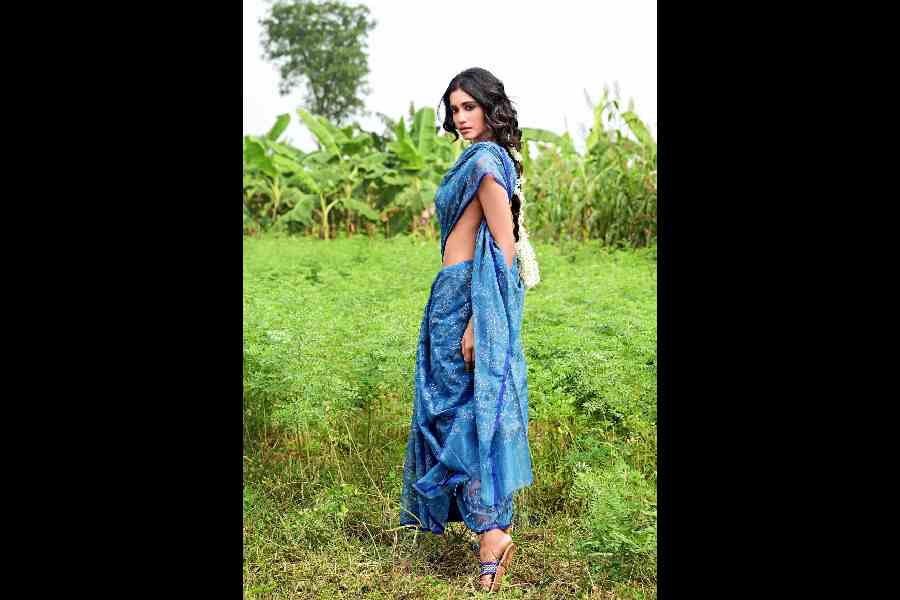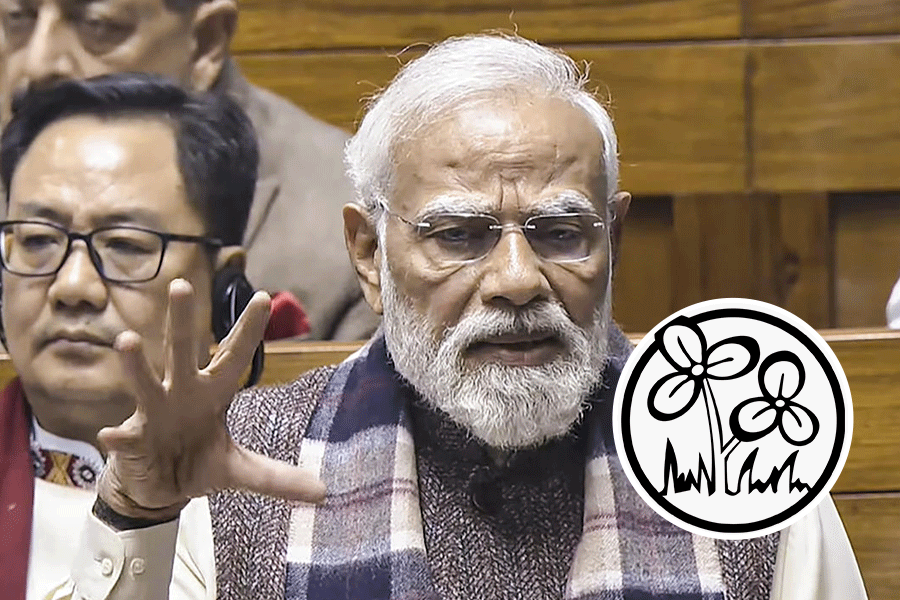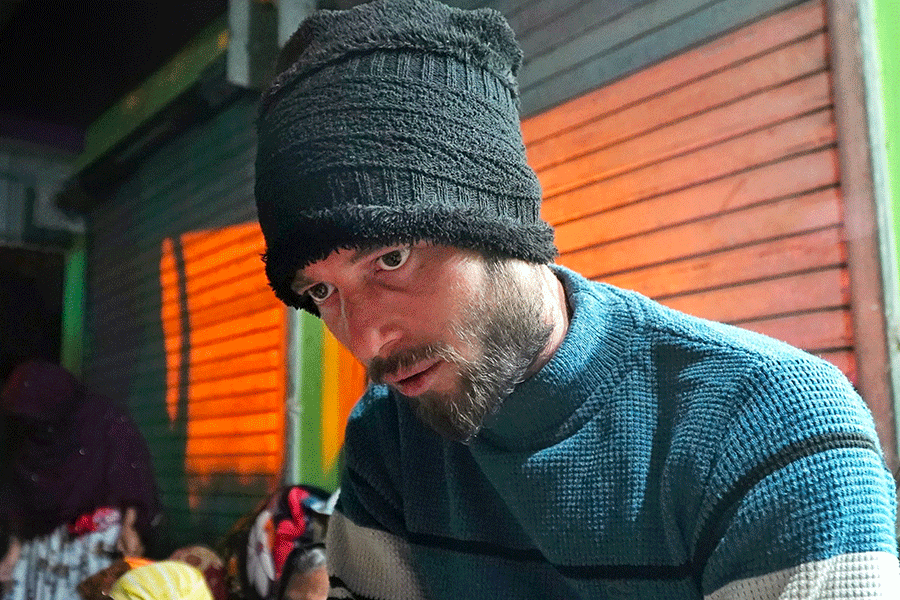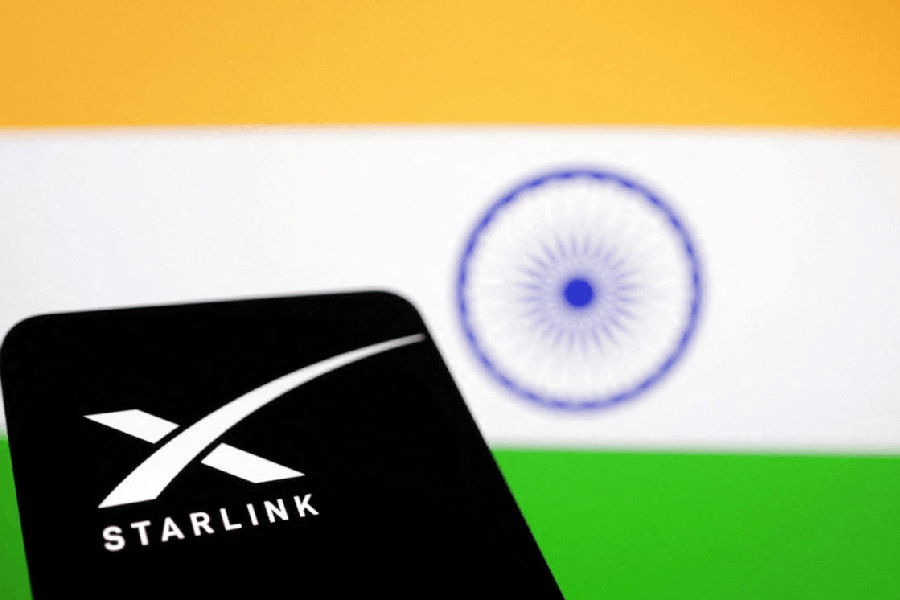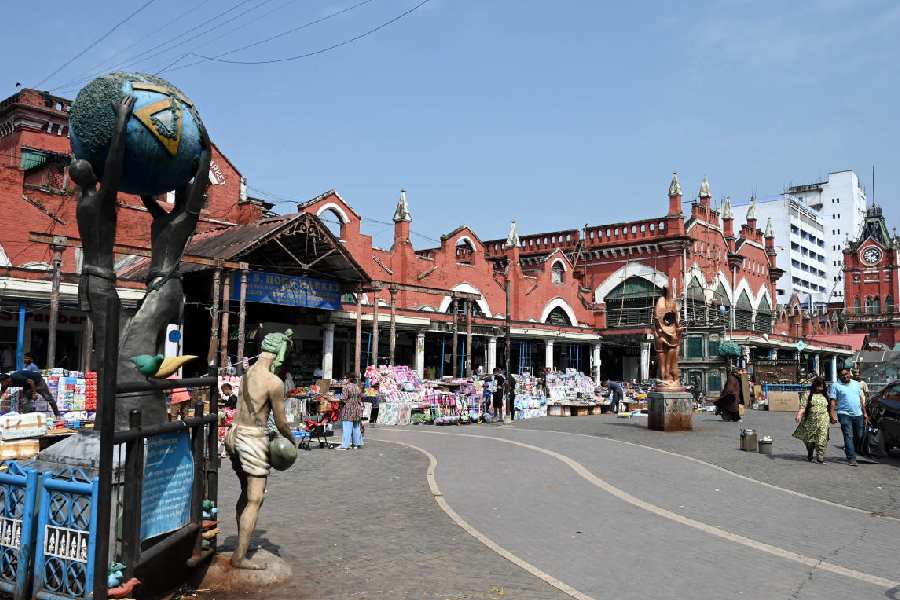In the Indian context, the deep and vibrant shade of indigo symbolises bravery, courage, and resilience. However, its infamous history in Bengal carries painful memories, marked by cruelty and misinformation surrounding its cultivation. This has led to what is often referred to as India’s “blue gold” remaining a rare commodity in Bengal rather than a widely commercialised product that could enhance the local economy.
Indigo, as a natural dye, holds significant importance in India’s socio-economic, political, cultural, and fashion landscapes, particularly in Bengal. “In India and Bengal, we don’t address exploitation in the same way that African Americans talk about slavery. The oppression and violence associated with indigo cultivation are harsh memories for the people in Nadia, often passed down through generations via oral storytelling. This has led to the idea of indigo being viewed as a ‘devil plant’ that took the lives of their ancestors and spoiled the soil. Even after so many years since the Blue Mutiny, Bengal has not been able to produce indigo commercially again,” designer Bappaditya Biswas of Byloom explains as he took us to Nadia district’s Phulia town for an exclusive shoot.
Catching a glimpse of indigo cultivation in Nadia, the birthplace of Blue Mutiny — turning the pages of history and in contemporary times
Bappaditya, who has been involved in indigo dyeing since 2005, recalls his first encounter with remains of indigo vats in Nadia during his student days. He notes that most of them are now non-existent or buried underground. Some vats have been unearthed by excavating homes, but they are often buried along with the memories of the past.
In Phulia, a village known for its handloom textiles, particularly taant, he nurtures his passion for this natural dye, from cultivation to finished products such as apparel, accessories, and home furnishings. “I began working with indigo around 2005 or 2006 after attending a conference in Hyderabad. I wanted to explore indigo because it has a profound history in Bengal. Indigo plantations were widespread in Bengal, producing some of the best indigo in the world, which was exported by the East India Company, as well as by the French and Portuguese. The profits from indigo were so substantial that it was almost equivalent to opium, making it highly lucrative for the East India Company and Bengali zamindars. However, this led to monocropping, forcing farmers to plant indigo year after year, which contributed to a man-made famine in Bengal. This event sparked the Blue Mutiny, the first peasant movement by indigo farmers who united to refuse planting indigo. Despite coercion and violence from the British, the farmers stood their ground. This history deeply moves me; a simple textile dye has the power to shape Indian history,” shares Bappaditya.

Bappaditya Biswas
When we arrived in Phulia’s Dhakuria, master weaver Sanjay Pramanik, aged 39, welcomed us to his 10-katha plot dedicated to indigo cultivation. Sanjay, who has been weaving for over 20 years, explains, “The idea that no other crop can be grown alongside indigo is a myth. For the past 10-15 years, I have cultivated other crops in this field during off-season.” He emphasises the labour-intensive nature of the process, which requires around 15 farmers during cultivation.
Bappaditya elaborates on his journey, stating, “Initially, we did not cultivate indigo. I sourced dye cakes from Tamil Nadu and Andhra Pradesh and dyed them in Phulia. We learned how to create natural vats, but extracting the colour proved challenging. It wasn’t until Covid-19 disrupted our regular work that I encouraged Sanjay to plant indigo seeds. His father was initially resistant due to the myth that indigo spoils the soil, but it actually improves soil fertility as a nitrogen-fixing plant.”
In a 10-katha plot, cultivating Indigofera tinctoria yields Sanjay approximately 1.5kg of indigo dye, which is insufficient for his year-round production needs. The cultivation process begins in May when the seeds are sown, and the subsequent 90 days are critical. After this period, the plants are cut, and the dyeing process begins, involving soaking, colour extraction, and oxidation. Gautam Basak, 47, comes from a family of generational weavers in the region and is a master weaver at Bappaditya’s production unit. He stated, “The humid climatic conditions of Nadia and the Gangetic delta soil are ideal for producing this crop. However, we are currently able to cultivate only 10 per cent of what we need. The remaining 90 per cent we must purchase. The main challenge is the availability of land, as rice is the primary crop cultivated here. Indigo is a cash crop and can only be planted once a year. In the future, we hope to commercialise it if we can find more land for cultivation. The 10 per cent we currently produce is of top-notch quality. Our aim is to establish a self-sustaining system, though we have a long way to go. The colour we achieve using just 10 per cent of the dye available in the market can be replicated with only 2 per cent of what we cultivate here.”
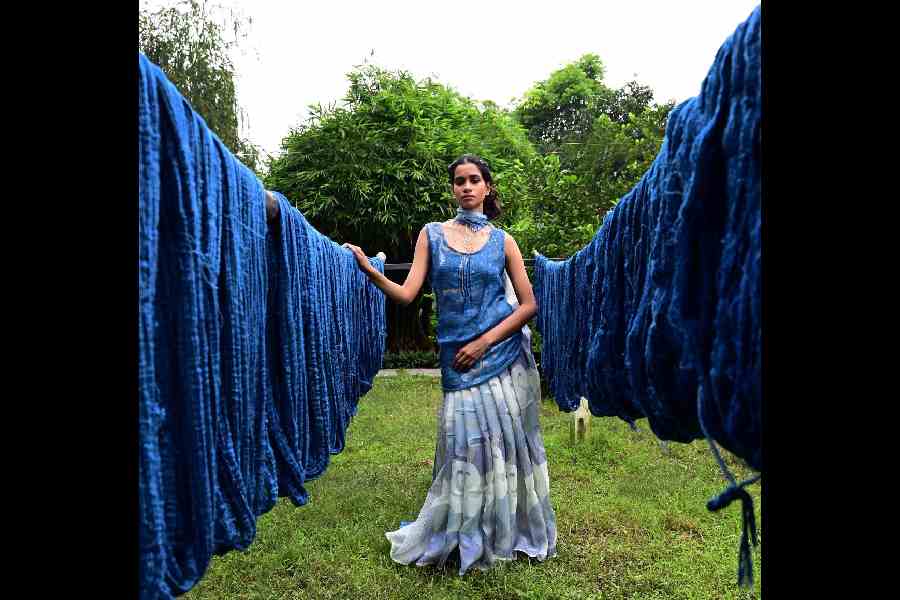
Meghna poses for a photo
Both Gautam and Sanjay are natives of Nadia but have never been able to trace any ancestral history related to the Blue Mutiny or the cultivation of indigo. They shared that their knowledge about the cultivation and oppression comes solely from books.
For Bappaditya, cultivating this small percentage of indigo is about preserving history and reclaiming the crop. “The pigment is only found in the leaves. Although we are unable to plant it commercially yet, we plant it every year. It is important to reclaim this crop. While what happened in the past is significant, it remains history. I keep planting indigo year after year, hoping that someday farmers will take it up for commercial cultivation again. However, until it becomes commercially viable, farmers won’t show interest. There are some sporadic experimental cultivation efforts happening in Bankura and Birbhum, but in Nadia, we are currently the only ones cultivating it. Others may have vats, but they do not engage in cultivation. My plantation serves more as a token of remembrance because I want the legacy of this crop to be preserved for future generations,” he explained.
Regarding the revival of indigo cultivation in Bengal in recent years, Bappaditya shared, “Indigo was cultivated throughout Chennai, Tamil Nadu, Andhra Pradesh, Gujarat, and Rajasthan, but the impact of the Blue Mutiny was felt most in Bihar’s Champaran and Bengal. These are the places where indigo cultivation ceased. German textile designer Jurgen Lehl has contributed to the revival of this practice, but much of the grassroots work is only happening in recent years. When we began cultivation, most people in the area didn’t even recognise the plant. Can you imagine a place where indigo cultivation was once so prevalent but now people can’t identify the plant?”
An indigo vat homestay and a peek into the dyeing process
Our one-day stay at the indigo vat of Byloom in Phulia’s Purba Pareshnathpur was indeed a memorable experience.
It is around five minutes by car from the Phulia station. Around 9am, the workers arrive at the dyeing unit to begin their daily work, which lasts eight to nine hours. In addition to vats for other natural dyes, the facility has two units with four vats where the indigo dyeing process takes place.
The shaded areas contain four cemented circles holding large earthen tumblers filled with heated dye. Despite wearing gloves, the dye can leave stains on the skin.
“What makes indigo special is that it is the only source of the colour blue in natural dyes. While the dye can stain hands, it is harmless. Many indigenous communities in Africa, as well as the Bedouins, have used indigo on their skin to protect against the harmful rays of UVA and UVB. It has medicinal properties and is actually beneficial for the skin,” Bappaditya said. He added that there are challenges in the dyeing process: “With chemical dyes, you dip once into the dye bath and the colour comes out. But with indigo, we need to dip the same yarn into the dye bath at least seven to 10 times. The more we dip it, the more the yarns get entangled, especially since we work with very fine, single hand-twisted yarns. That presents a significant challenge.”
After the plants are harvested after 90 days, the leaves are soaked overnight in water to extract the dye. The Byloom unit employs traditional natural vats for the dyeing process. “Our forefathers researched and developed these vats. The great advantage is that this process has no environmental impact. We had Charllotte Kwon, a researcher and scholar specialising in natural dyes, particularly indigo, come with her team from Vancouver to set up the vats. She is the founder of the brands Michel and Maiwa and stayed in the village for 30 days and helped us establish the permanent vats. She still returns every year to place orders to ensure that the vats remain operational,” said Bappaditya. He further explained that the vats are like living organisms that function based on the fermentation process. Bacteria help break down the dye molecules, so the vats need regular feeding. While there are ways to rejuvenate vats, they must be continuously fed while in regular operation. Different fruits are used to prepare different vats, as the fructose helps in fermentation and enhances the dye by reducing the indigo content. “When we use our banana vat or date vat, we must keep adding banana pulp and date sweet water to the vat, allowing the bacteria to thrive. If we don’t use it for an extended period, it can die, but it can also be revived. That’s the beauty of a natural vat.”
Soaking the leaves overnight allows the pigments from the leaves to dissolve into the water, which is then oxidised to achieve the blue colour. Only cement or earthen utensils are used in the process to prevent impurities from contaminating the dye and spoiling the utensils, ensuring the colour remains intact. Dyeing 10kg of yarn takes about 24 hours. “If we aim for a lighter shade, dyeing for one day is sufficient. However, to achieve darker shades, we need to add an extra day for each additional darkness. The dyed threads must be dried in the shade, and sometimes the rainy season right after the 90 days can complicate the drying process, causing the threads to fail to hold the colour. The entire dyeing and drying process requires about 10 days to achieve the desired result,” Gautam explained.
Sanjay recalled how they adapted their dyeing process over time. “Initially, we used chemical caustics in the dyeing process. However, our clients informed us that they couldn’t purchase products dyed with those chemicals, so we shifted to a fully natural, fruit-based dyeing process. We conduct a lot of experiments in the dyeing process. While banana and date are commonly used, we have also experimented with seasonal fruits like mango and jackfruit, as well as manjistha.” Bappaditya, Gautam, and Sanjay have worked with silk, cotton, wool, and linen threads in the dyeing process. Dyeing 10kg of thread requires nearly 20 labourers. Adding to Bappaditya’s thoughts on the challenges of the dyeing process, Gautam noted, “The unevenness of colour is a significant challenge in indigo dyeing compared to other natural dyes. Indigo takes longer to absorb into the threads, and the colour turns out best on wool. The process can vary based on the fruit used, particularly if we opt for seasonal fruits like mangoes or jackfruits.”
Weaving indigo-dyed threads into apparel, accessories and home furnishing
Our last stop on the indigo trail was a weaver’s unit at Habibpur in Phulia, where we witnessed the handloom weaving of the dyed threads into saris adorned with beautiful designs that are painstakingly crafted, straining the eyes and the hands. Moving away from the traditional designs and fabrics of indigo-dyed apparel, Bappaditya has experimented with the dye’s versatile appeal by enhancing his apparel creations with zari and sequins and incorporating a variety of fabrics in his Byloom collection, including muslin and cotton. “We treat it as we would any other natural dye. We are known for our funky and trendy designs, and we have applied the same creativity to our indigo collection. This approach adds a modern value to the colour. I believe there’s also an emotional connection to this colour — our collection of indigo always sells out quickly. People love it and feel attached to it. There’s something magical about this colour,” Bappaditya remarked.
Despite the available powerloom machines in their village which can expedite their work, Gautam and Sanjay prefer handloom weaving. “Handloom is very labour-intensive, yet it is close to our hearts because it truly preserves our craft and showcases our skills in bringing to life the designs our designer provides based on customer requirements. There is a demand for our handloom weaves in indigo because we can offer new designs that meet their expectations,” the duo shared.
They also noted that weaving indigo threads on a handloom requires a certain skill, as the threads can easily get damaged. A muslin Jamdani takes about one-and-a-half months to weave. “Not all weavers can work with indigo-dyed threads; it takes a lot of skill,” Gautam shared, noting that his son has now joined him in the business. “Many say that the next generation isn’t interested in handloom weaving, but when the practice continues with deftness, it provides profit and that sparks their interest. It is all about what we offer and textile weaving in handloom is all about innovation.”
Both Gautam and Sanjay agree that indigo-based handloom weaves are not as popular locally as they should be. While they have many foreign clients, they believe local demand should be higher. Gautam noted, “One reason for the low local demand is the price. The price is high due to very limited local production of the dye. Another reason is longevity. The colour is appealing but requires careful maintenance, including less exposure to sunlight and proper washing to prevent fading.”
On our way back home from the trail, Bappaditya shared the potential of indigo-based handloom weaves in both local and export markets, stating, “There’s a huge opportunity because the entire world, especially Western countries, is increasingly interested in environmentally sustainable dyeing practices. This process uses no chemicals, so if it spills on the ground, it doesn’t pollute the soil or water. In contrast, chemical dyes can contaminate groundwater. However, because local production is low, prices remain high. I want the colour to remain in our collective memory; it’s something we shouldn’t forget. That’s why I continue to create indigo collections year after year, and they always sell well. There is a global demand for indigo. And the skill of handloom weavers allow us to innovate with designs making it contemporarily relevant.”
Model: Meghna Bose
Outfits: Byloom
Styling: Anupam Chatterjee
Hair and Make-up: Bhaskar Biswas

